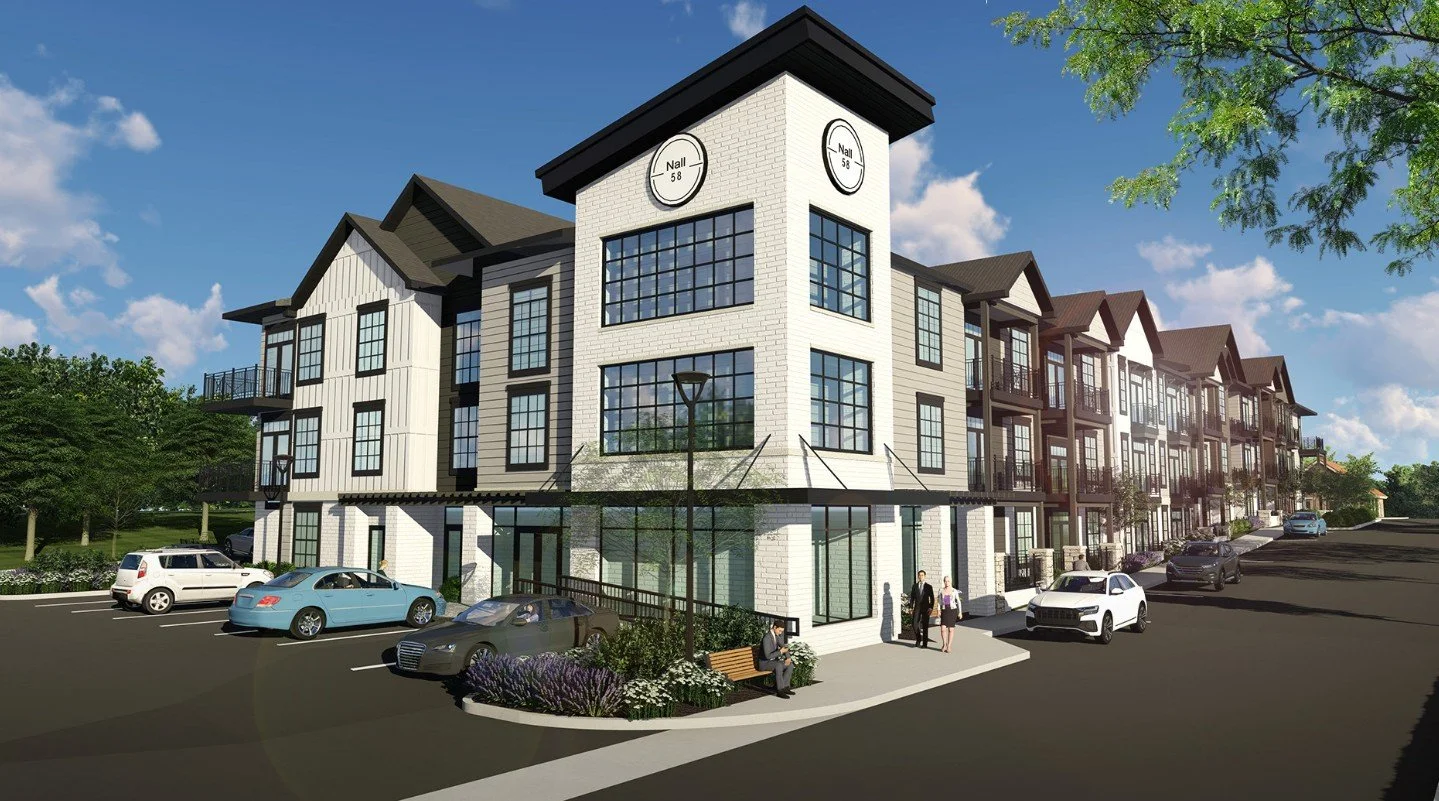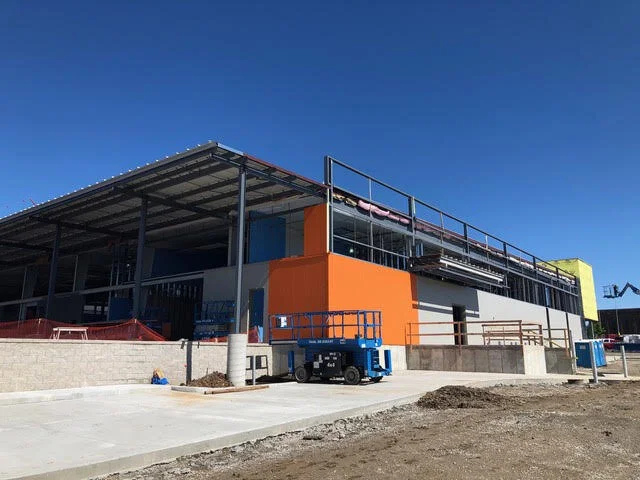Photo credit: Shawnee Economic Development Council
$60 million 'The Residences at Galleria' to open in 2022
The Residences at Galleria, a $60 million multifamily complex located adjacent to the former Sprint World Headquarters in the Galleria 115 development in Overland Park, Kan., is set to begin construction this summer and slated to open in 2022.
The four-story, luxury apartment complex is included in the first phase of the 5-plus acre development by Block Real Estate Services, LLC (BRES). The $350 million Galleria mixed-use development master plan includes two apartment buildings, office space, retail and entertainment.
JLL Capital Markets (JLL) arranged $21 million in joint venture equity partnership with Hartford Investment Management Company (“HIMCO”) on behalf of BRES for the development of the 322-unit, Class-A, podium multi-housing community.
"We are excited to partner with HIMCO on this project, and, from the beginning of discussions with them, it was clear that we had a shared vision for the quality of this project and its high-demographics location within Overland Park” said Ken Block, BRES managing principal.
The Residences include 322 one-, two- and three-bedroom units and will average 927 SF. Features include high ceilings, large walk-in closets with custom shelving, high-end appliances and finishes, European-style cabinetry, outdoor terraces, in-unit laundry rooms with full-size washers and dryers, double-paned windows and more.
A hallmark of the new community, designed by Hoefer Wysocki, is the walkable lifestyle. Adjacent to the site is a thriving commercial corridor, multiple entertainment districts, theaters, and endless restaurant choices. Outdoor patios are linked to The Residences by walking trails that encircle greenspace, sitting areas, a rolling rock waterfall and dog park.
"We are very excited to work with Block Real Estate Services on the Galleria. This community will raise the bar on luxury living in the area,” said Hoefer Wysocki vice president and director of multifamily design, Chris Armer, AIA, NCARB.
The project will feature the best community amenities offered in the submarket and include a large resort-style swimming pool with shallow ledge features; pool deck with cabanas, hot tub, sports courts and water features; fitness center with Peloton bikes, massage therapy and virtual training; outdoor group fitness areas; clubhouse with fireplace, game room and social media room; executive business center; dog park and pet spa; and covered and surface parking.
“Galleria will be BRES’ most exciting project to date, building on our successful experiences with this high-end podium product, which allows for a large, outdoor amenity deck and other amenities that are unique in this market,” Block said.
The JLL capital markets debt placement team representing the borrower was led by executive managing director Jody Thornton, senior director Mark Erland, director Matt Benson and analyst Kellan Liem.
Other partners on the development team include Titan, Polsinelli and McClure.
Grocer's Warehouse complex sells to Taing Capital Group
The Grocer’s Warehouse complex, anchored by Hufft Architecture and Fabrication in the historic Roanoke Park neighborhood of Kansas City, Mo., has sold to Taing Capital Group, LLC.
Originally a manufacturing facility built in 1949 by Kansas City grocer Fred Wolferman, the iconic building was redeveloped into creative office and living space in 2015. The 60,000 SF building has seven commercial tenant spaces and studio loft apartments.
Hufft plans to remain in its current space as the GW anchor, along with the other tenants including Studio Lofts, Real Fitness & Conditioning, Pure Workplace Solutions, Roanoke Park Conservancy, MEDiAHEAD and ZancTank Concepts.
“We have realized our master plan for the Grocer’s Warehouse campus and properties. It has been a phenomenal process to see it transform. While our primary roles lie in running Hufft, we were ready for a group to take over the management and all of the responsibilities that come with that. We are very much looking forward to staying a part of the GW campus and Roanoke Park for a long time. The Roanoke Park Conservancy is really to be credited for their efforts in making this location a desired place to work and live. That group holds the original visionaries that believed in this beautiful area of Kansas City,” said Hufft co-founder and principal, Jesse Hufft.
Logan Freeman of Clemons Real Estate and Parker Webb with Third Space Property Group represented the buyer and Pat Murfey of Evergreen Real Estate Services represented the seller in the June 2020 transaction.
"This was a great collaboration between the current ownership group and the new buyers. It was definitely an uphill battle with the pandemic and commercial tenants being a large percentage of the rental income. Securing financing was tricky, but we had a local lender step up who believed in the project as much as we do. Both sides worked together great and are going to continue this vision for the Grocer’s Warehouse and the surrounding Roanoke Park area," Freeman said.
Read previous Grocer’s Warehouse stories by MWM here:
CCIM economist navigates road to recovery
K.C. Conway, chief economist of the CCIM Institute and director of research for Alabama Center for Real Estate, delivered an economic update webinar to commercial real estate professionals last week.
As a whole, Conway believes the economy, which spiraled downward with the COVID-19 lockdowns, is far from recovery, a perspective reinforced by recent comments from Jerome Powell, chair of the Federal Reserve.
“If we were recovering and creating 2.5 million jobs a month, do you think the Fed would make the statement that it was not even thinking about making interest rate hikes until 2022? Not even 2021? This tells you how fragile the economy is; how much intervention the Fed is going to have to do,” Conway said.
Conway predicts that there will be a massive oversupply of oil as supply cut production agreements expire at the end of June.
“I think energy is going to remain very, very volatile. That’s good for the consumer and for transportation, but it’s not a good indicator that things are really recovering from the economy. I don’t think energy is saying we’re there yet either,” Conway said.
The housing market also does not reflect a recovery. With eight percent of mortgages subject to forbearance agreements which won’t expire for six to 12 months, Conway said we’re not going to fully understand the impact of housing until next spring.
“When you also look at what’s rising in terms of mortgage delinquencies, we’re essentially at 15% of all homeowners delinquent in their mortgages or in forbearance, and that’s record numbers even compared to 2009,” noted Conway.
According to Conway, there are four metrics which are most predictive in determining when we’ve arrived at recovery. The first is the Transportation Security Administration (TSA) daily passenger count, which is currently in the 200,000 to 300,000 range.
“If we don’t see this climb back toward 1.5 million this fall, we are in serious trouble," Conway said.
The second metric upon which he relies is the number of loans transferred to special servicers. He noted that these loan transfers are reaching record numbers.
The third predictive metric is transaction activity. Conway said that activity currently is locked up because the 500 largest pension and institutional funds are not investing in commercial real estate until they get past their mark to market accounting at the end of June and determine how to reallocate capital. However, Conway is optimistic.
“Capital is coming back this fall to commercial real estate,” he said.
The fourth and final predictive metric is corporate earnings. He encouraged his audience to follow the earnings of companies that drive their local economies, including those companies that are the major tenants of local retail centers and office buildings.
Conway also predicts major changes to logistics.
“What we’re going to see is the rest of the world awaken to the fact that it’s a really bad idea to put all of your manufacturing dependence in one place in the world.”
Consequently, he said some of the manufacturing currently done in China or other parts of Asia will move back to Europe and the United States, but much will go to Mexico, increasing the importance of Kansas City, local intermodal installations and Kansas City rail as trade moves more north and south, rather than from the west coast to the east coast.
Conway noted that casualties of the pandemic will include the failure of one in four businesses and the closure of 40 percent of restaurants nationally. Consequently, a lot of inventory and equipment that was ordered pre-pandemic but not shipped during the shutdown will arrive at businesses that have closed.
“That’s about 50 million SF of additional warehouse space that we’re going to have to have to store orders that have finally come in. This will provide adaptive reuse opportunities for properties like closed big box retailers and department stores in enclosed malls,” Conway said.
Conway predicts leisure and travel properties will change substantially as well, shifting hotels in the future to be smaller with exterior room entry and contactless features.
In addition, Conway sees every ratio to which the commercial real estate industry is accustomed, to change.
“Density ratios in office, density ratios in restaurants, expense ratios, occupancy cost ratios . . . parking ratios because we’re going to do more ‘click it and pick up,’ rather than ‘park and drive in,’ which will add a whole new dimension to future site selection,” Conway said.
“What I think is going to make the difference is what’s called immunity passports,” which currently are being utilized in Europe.
Immunity passports in the United States will rely upon technology that is already available, although HIPAA laws will need to be amended.
Conway predicts that within two years, we are going to have mouth swab kits to test for antibodies.







